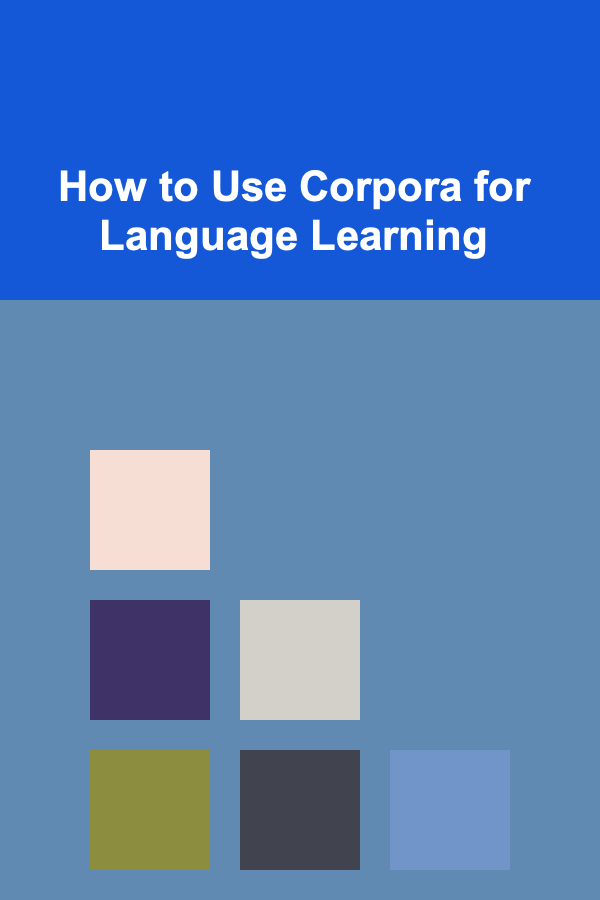
How to Use Corpora for Language Learning
ebook include PDF & Audio bundle (Micro Guide)
$12.99$7.99
Limited Time Offer! Order within the next:

Language learning has evolved significantly over the past few decades, particularly with the rise of digital resources and computational linguistics. Among the various tools that have emerged, corpora (plural of corpus) have proven to be invaluable in enhancing language acquisition. This article explores what corpora are, how they can be effectively used in language learning, and the various methods and tools available for leveraging these resources to improve linguistic skills.
What Are Corpora?
A corpus is a large, structured collection of texts or spoken data that reflects authentic language usage. Corpora can be designed for different languages, time periods, and contexts, and they typically contain a variety of texts such as newspapers, books, academic papers, dialogues, and even social media posts. These texts are often annotated with additional information, such as grammatical structures, parts of speech, or word frequencies, which makes corpora a rich resource for linguistic analysis.
There are several types of corpora, each serving different purposes:
- General Corpora: These are large, diverse collections of texts from various genres and contexts, providing a broad view of language usage.
- Specialized Corpora: These focus on specific domains or genres, such as medical texts, legal documents, or children's literature.
- Spoken Corpora: These consist of transcriptions of spoken language, which are essential for understanding conversational speech, slang, and phonetic variations.
- Parallel Corpora: These contain texts in multiple languages, often used for translation studies and bilingual education.
- Learner Corpora: These are collections of texts produced by language learners, offering insights into common mistakes, errors, and learning patterns.
By analyzing corpora, learners can observe how native speakers use language in various contexts and gain access to authentic, real-world examples.
Why Use Corpora for Language Learning?
The use of corpora in language learning offers several key advantages over traditional textbook-based approaches:
1. Exposure to Authentic Language
Textbooks and classroom exercises often provide simplified or contrived examples that may not fully reflect how language is used in real life. Corpora, on the other hand, offer learners direct access to authentic language in context. This means that learners can observe how words, phrases, and structures are used in actual conversations, media, academic discussions, and other real-world situations.
2. Contextual Learning
One of the main challenges in language learning is understanding how words and expressions change meaning depending on the context. Corpora help learners see words in their natural environment, allowing them to understand not only the meaning but also the appropriate usage of words in various contexts. For instance, a word like "bank" could refer to a financial institution, the edge of a river, or a place for storing things. By studying corpus examples, learners can see the different ways "bank" is used, helping them internalize these nuances.
3. Vocabulary Building
Corpora are an excellent resource for vocabulary acquisition. By analyzing frequent collocations (i.e., words that commonly occur together) and common phrases, learners can improve their vocabulary in a more natural, intuitive way. Additionally, corpora can highlight regional variations in language, helping learners understand different dialects or slang.
4. Insights into Grammar and Syntax
Corpora also provide insights into grammatical structures, sentence patterns, and syntax. By analyzing large quantities of text, learners can see how native speakers construct sentences, use tense, or form questions. Learners can also explore grammatical variability, such as different ways of expressing the same idea.
5. Error Detection and Correction
Learner corpora can be particularly useful for identifying common mistakes made by language learners. By analyzing errors in written or spoken language, educators and learners can pinpoint areas where the learner is struggling and work on correcting those specific issues. This is particularly helpful for advanced learners who want to fine-tune their grammar and fluency.
How to Use Corpora for Language Learning
Now that we understand the importance of corpora, let's explore practical ways in which they can be used to enhance language learning.
1. Text Mining and Concordance
Concordance refers to a list of all occurrences of a word or phrase within a corpus, along with the surrounding context. By examining the concordances of a word, learners can understand its different uses and meanings in context. For instance, if a learner is studying the word "run," they can examine its usage in a corpus to identify whether it is being used in the sense of running as a physical activity, or in metaphorical phrases like "run into trouble."
Text mining involves extracting useful data from a corpus, such as the most frequent words, phrases, or collocations. Many corpus analysis tools, such as AntConc and WordSmith, allow users to mine large corpora for these patterns.
2. Collocation Analysis
Collocations are groups of words that often appear together. For example, "make a decision" and "strong coffee" are common collocations. Understanding collocations is vital for mastering natural-sounding language. By studying a corpus, learners can identify common collocations in different contexts and then practice using them in sentences.
3. Using Corpus-Based Tools
Several online tools and software are available that allow learners to interact with corpora in different ways. Some of the most popular corpus-based tools include:
- COCA (Corpus of Contemporary American English): COCA is a large, freely available corpus that provides a wide range of texts from spoken, fiction, magazine, and academic genres. Learners can use COCA to search for specific words, phrases, or grammatical patterns.
- Sketch Engine: This tool allows learners to explore various corpora and provides powerful features like word sketches, which show the grammatical relationships of a word, and concordance lines to analyze its usage in context.
- BNC (British National Corpus): The BNC is a widely used corpus that contains samples of written and spoken British English. It is particularly useful for learners who want to explore British English language usage.
- Linguee: This is a bilingual corpus that provides translations and examples from multiple languages. It is particularly useful for learners studying a foreign language as it shows how phrases and words are used in parallel texts.
- AntConc: A free concordance software that allows learners to analyze and visualize patterns in large corpora. It's especially useful for learners who want to search for specific phrases or examine word frequency.
4. Incorporating Corpora into Language Lessons
Language teachers can use corpora in the classroom to create meaningful, context-rich lessons. Teachers can present learners with real-world examples of language use, based on corpora data, instead of relying solely on textbook exercises. For example, a teacher might show learners a concordance of a particular verb, followed by discussions about how that verb is used in various contexts. Teachers can also use corpora to identify common language mistakes made by learners and target those in subsequent lessons.
5. Personalized Learning with Corpora
Another advantage of corpora is that they allow for personalized learning. Learners can explore topics that interest them by analyzing corpora related to those specific subjects. For instance, a student interested in business English can explore a business corpus to identify common phrases and structures used in professional contexts. Similarly, learners can search for specific grammar patterns or expressions that they are struggling with and find examples in authentic language.
6. Self-Study with Corpora
For independent learners, corpora can be an invaluable self-study resource. Learners can explore different corpora, search for their target language, and analyze the data at their own pace. By using corpus-based activities like word frequency analysis, collocation discovery, or studying phrase patterns, learners can tailor their study sessions according to their needs and goals.
7. Utilizing Parallel Corpora for Translation Practice
Learners studying a second language for translation purposes can benefit from parallel corpora, which contain texts in two or more languages. By examining how a word or phrase is translated in various contexts, learners can improve their translation skills and learn more about the subtle differences between languages. Parallel corpora are particularly valuable for translating idiomatic expressions and culturally specific terms that don't have a direct translation.
Challenges and Considerations
Despite the many benefits of corpora, there are some challenges and considerations to keep in mind when using corpora for language learning:
1. Data Overload
Corpora can be vast, containing millions of words or more. It can be overwhelming for learners to process such large amounts of information. To overcome this challenge, it's important to focus on specific types of data, such as a particular word or phrase, and analyze it in context. This approach helps avoid information overload and ensures that learners can focus on relevant language features.
2. Corpus Accessibility
Not all corpora are freely accessible, and some require specialized software or subscriptions to access. While there are many free corpora available online, learners may need to invest in paid tools for more advanced analysis or access to larger corpora. However, many tools offer trial versions or educational discounts.
3. Learning Curve
Using corpora effectively requires some level of technical knowledge, such as familiarity with concordance tools or corpus analysis software. Some learners may initially find it challenging to navigate these tools. However, with practice and tutorials, learners can quickly become proficient in using corpora to enhance their language skills.
4. Incomplete Representation of Language
While corpora provide rich and authentic examples of language usage, they are not exhaustive. Some corpora may overrepresent certain genres or demographics, leading to potential biases in the data. It's important to recognize the limitations of a corpus and supplement corpus-based learning with other resources, such as conversations with native speakers or immersion experiences.
Conclusion
Corpora offer powerful tools for enhancing language learning, providing learners with authentic, contextual examples of language use. By utilizing concordances, collocation analysis, and various corpus-based tools, learners can gain a deeper understanding of vocabulary, grammar, syntax, and more. Whether used in the classroom, for independent study, or for personalized learning, corpora help learners engage with real-world language and gain the skills needed for fluency. As computational tools and corpora continue to advance, they will undoubtedly play an even more significant role in the future of language learning.

How to Improve Your Home Security with Regular Maintenance Checks
Read More
How to Understand Web3 and the Metaverse
Read More
Save Money on Meal Delivery Services: Best Discounts, Hacks, and Meal Plans
Read More
How to Save Money on Home Repairs and Maintenance
Read More
How To Find Your Moral Grounding
Read More
How To Choose the Right Community for Your FIRE Journey
Read MoreOther Products

How to Improve Your Home Security with Regular Maintenance Checks
Read More
How to Understand Web3 and the Metaverse
Read More
Save Money on Meal Delivery Services: Best Discounts, Hacks, and Meal Plans
Read More
How to Save Money on Home Repairs and Maintenance
Read More
How To Find Your Moral Grounding
Read More